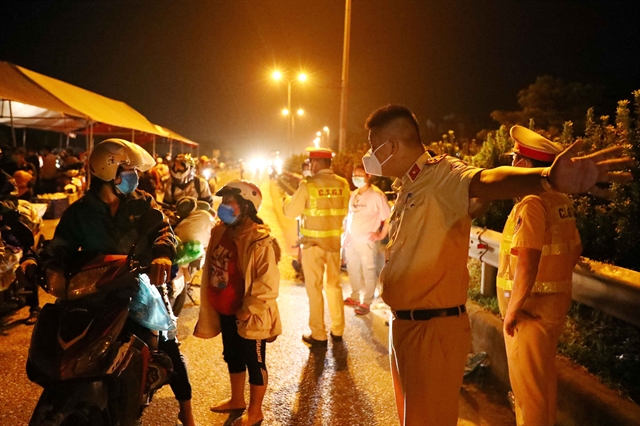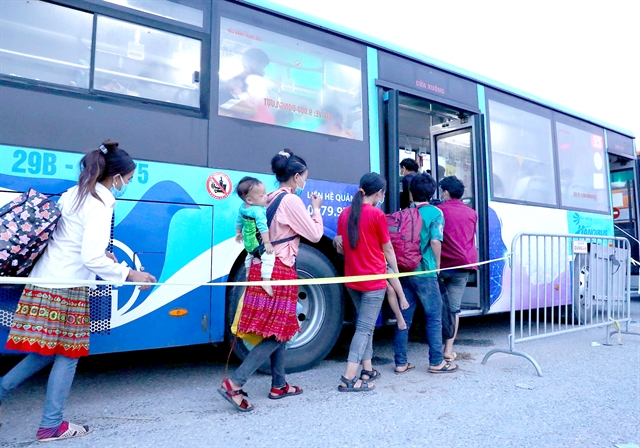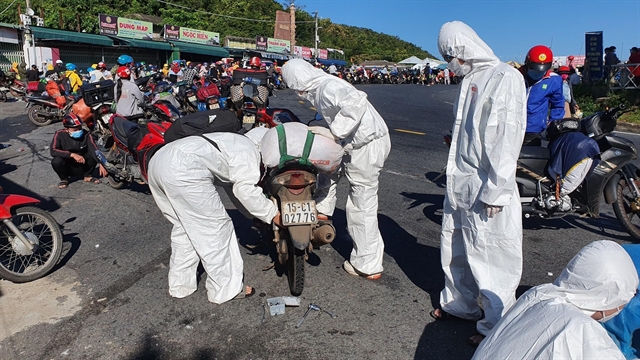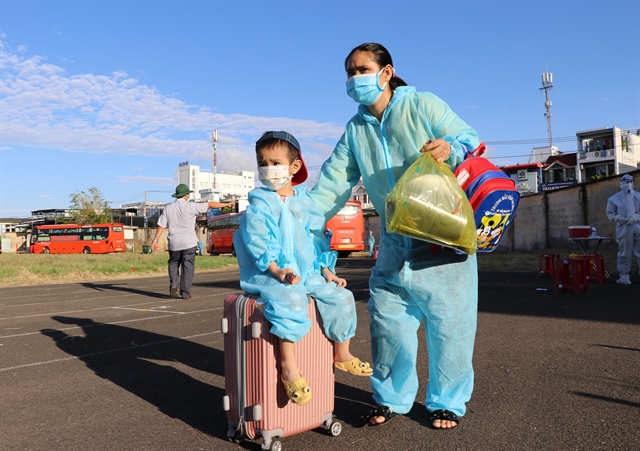 Society
Society


|
| Hà Nội Police guide returnees from the south to northern mountainous provinces on Wednesday night and early Thursday morning. — VNA/VNS Photo Phạm Kiên |
Khánh Dương
HÀ NỘI — It is common to see people flocking to their hometowns on public holidays or maybe for Tết celebrations to welcome the new year.
Sometimes a trip home can be just to relax and catch up with family and old friends.
But over the past few days, the tens of thousands of people leaving HCM City are just desperate to leave the southern hub after months locked in due to strict social distancing regulations.
Now restrictions have been lifted, it's no time for a holiday, just time for a much-needed change of scenery and a chance to live in their own homes without worrying about mounting costs.
But there are concerns with such large numbers of people congregating at checkpoints, often in crowds. COVID is still a huge threat, and those making the journey are urged to do so safely.
Congestion on many of the major highways is also a cause for concern, and one group of around 200 people needed police assistance after heavy rain flooded roads in central provinces.
Watch our video on people receiving help from the police on the way home
But many migrant workers who lost jobs when HCM City 'closed down' have no money to make ends meet in urban areas. This is their only option in the hope they can earn a wage after more than 100 days of social distancing.
They took any means of transport they have to make the journey home.
They rode bicycles or motorbikes for more than 1,000km from southern localities to head to northern mountainous areas.
For those who lost everything including their modes of transport, they were forced to walk the great distance on foot.
Close-up photos on social media over the past days revealed how exhausted the migrants, with piles of belongings on their vehicles, actually were.
A man lying on a motorbike using the opportunity to get some much-needed sleep while waiting at a checkpoint; a family of four on an outdated motorbike fleeing HCM City or the smile of an eight-month pregnant woman who finally reached her destination with her husband.
What will be waiting for them in their hometowns after they return? Can they continue to survive?
They don’t know.
But whatever lies ahead, it has to be better than the lives they've led recently.
Vietnam General Confederation of Labour (VGCL) predicted that the mass exodus would cause a number of problems including a labour shortage in southern localities and an increasing unemployment rate in localities when migrant workers return.
The ongoing mass exodus has pushed many local businesses in the south to the verge of bankruptcy due to a lack of labourers.
Lê Minh Tấn, director of HCM City Department of Labour, Invalids and Social Affairs, said in five months of social distancing between May and September, about 500,000 labourers left jobs and 1.7 million others had work contracts suspended without pay.
According to HCM City’s Centre of Forecasting Manpower Needs and Labour Market Information, the labour recruitment demand of local businesses will increase in the fourth quarter of this year with between 42,000 and 56,000 workers needed.
Bình Dương Province’s authorities forecast the locality will lack up to 50,000 labourers when local businesses resume operations.
In the latest document sent by VGCL to local labour confederations on Thursday evening, the VGCL said southern localities need to call on workers to go back to work and at the same time ensure competitive salaries to attract labourers.
The VGCL also proposed organising vehicles to take workers back or offer travel expenses and other fees to encourage labourers to return to businesses.
Acts of kindness
On the way home, there have been many acts of kindness.
Hà Nội police have guided migrants who drove thousands of kilometres from the south, passing through the capital city on their way to northern mountainous localities.
Buses of Hanoi Transport Services Corporation which have remained static in the two months of social distancing have been mobilised to take nearly 2,000 migrant workers and their families home.

|
| After arriving at a COVID checkpoint in Phú Xuyên District, Hà Nội, returnees are transported by the city’s buses to their destinations. — VNA/VNS Photo Phạm Kiên |
We have also seen voluntary groups offer free meals and drinks to returnees stuck in traffic jams or help those in trouble fix their vehicles.

|
| Students volunteer in Đà Nẵng helping returnees fix motorbikes on Hải Vân Pass. — VNA/VNS Photo |
Timely move
Local authorities of provinces and cities have different policies towards the returnees, depending on the capacity of quarantine sites and the priority of each locality.
Joint efforts by southern localities to welcome returnees home are a positive sign and worth recognition.
The Mekong Delta province of Long An was the first southern locality to make the move, contacting authorities of the returnees’ to ensure safe passage.
Long An’s authorities will be in charge of checking documents, test results and vaccination certificates before migrant workers leave the province. Authorities of provinces where workers arrive will collaborate to welcome and take them to quarantine sites as required.
Long An’s plan has eased congestion, limited the risk of infection and also shows a humanitarian act to support those who want to go home.
Other provinces like Phú Yên, Nghệ An, Bà Rịa-Vũng Tàu, An Giang and Cà Mau have also arranged vehicles or mobilised forces to welcome workers home ensuring safety and avoiding congestion.

|
| Phú Yên's local authorities mobilised 30 coaches on Thursday to take more than 1,000 labourers home from Bình Dương. — VNA/VNS Photo Phạm Cường |
At the COVID meeting with local authorities nationwide in early October, Prime Minister Phạm Minh Chính asked HCM City and southern localities who have a large number of migrant workers to organise transportation in order to take migrant workers home safely.
“If residents really wish to return for various reasons, local authorities must work together to organise transportation, ensure pandemic and traffic safety, and not cause public inconvenience,” he said.
The PM’s direction has clearly shown Việt Nam’s motto of ‘not leaving anyone behind’ in any situation.
In a timely move, Deputy PM Vũ Đức Đam on Thursday sent a dispatch urging local authorities to persuade residents to stay while providing support for them and resuming safe production and trade.
For those wishing to return to their hometowns, localities must inform authorities of their destinations to organise the transportation, especially for the elderly, pregnant women and children.
The Deputy PM also urged destination localities to receive the returnees and implement pandemic prevention and control measures in line with regulations.
Earlier Phạm Đức Hải, vice chairman of HCM City Steering Committee on COVID-19 Prevention and Control, said the city’s High Command would work with relevant agencies to organise trips for those who want to return, giving priority to the elderly, pregnant women, sick people and children.
Those who wish to go home can contact authorities of their residential quarters, wards or towns where they register for temporary residence or call hotlines 069.652.401 and 02866.822.000 for support.
Like the pandemic prevention and control work, managing the flow of people heading home is apparently the job of not any single locality but needs smooth collaboration of all, and must satisfy public wishes while at the same time keep the pandemic under control.
None of this can be achieved without the cooperation of those making the journey, and the thousands of officials and volunteers who are with them every step of the way. — VNS




